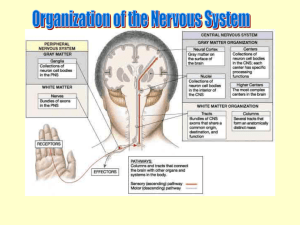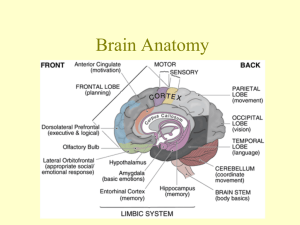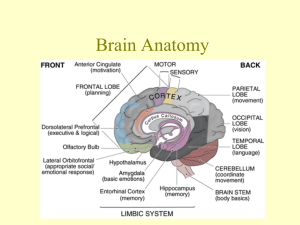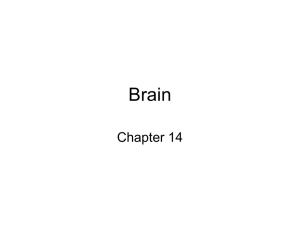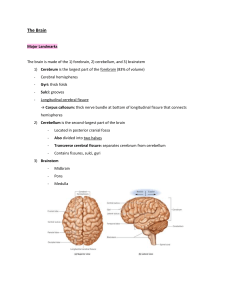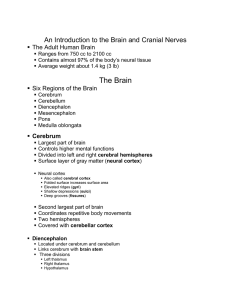Brain Physiology MMHS Anatomy and Physiology Chitraroff
advertisement
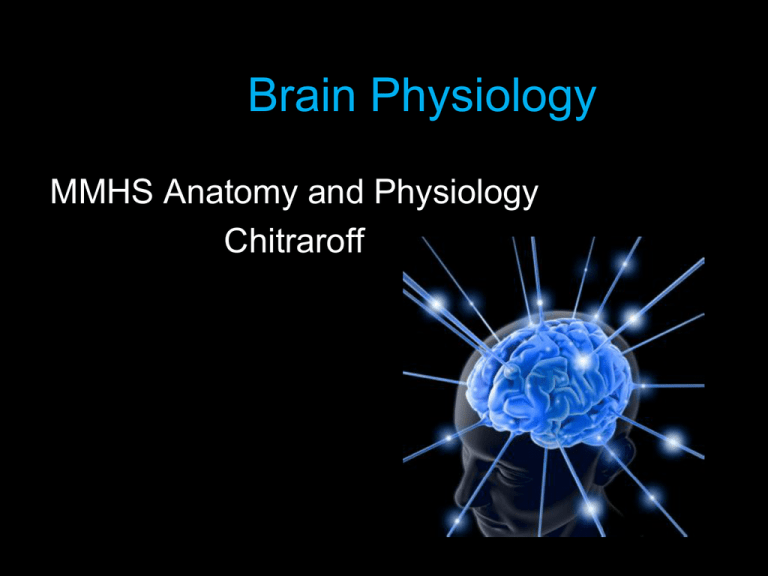
Brain Physiology MMHS Anatomy and Physiology Chitraroff I. Cerebrum: Motor and Sensory A. Motor/Sensory=send and receive information. 1. Primary Motor Cortex – directs voluntary movements. 2. Primary Sensory Cortex – receives information regarding touch, pressure, pain, taste and temperature. 3. Other sensory areas….see CNS chart! Cerebrum B. Association Areas = interpret incoming and outgoing information. 1. Premotor cortex – coordinates learned motor responses (recognition of letters and words and eye movements across a page). 2. Visual Association—understanding of letters and words. Cerebrum C. Integrative Centers 1.General Interpretive Area a. receives information from all sensory association areas. b. present in only 1 hemisphere (usually left). c. helps to understand what is read or heard. Cerebrum C. Integrative Centers 2. Speech Center— ”Broca’s Area” a. Impulses come from general interpretive area. b. Regulates breathing and vocalization for normal speech. c. Motor commands regulated by “Wernicke’s Area”. Speech Broca = (anterior) production of speech. Wernicke = (posterior) speech comprehension of speech. Cerebrum D. The Limbic System 1. 2. 3. 4. Establishes emotions. Links conscious and unconscious actions. Memory storage and retrieval Reticular formation a. Produces heightened alertness (stimulated) b. Lethargy/sleep (inhibited) Cerebrum E. Diencephalon 1. Origins of pairs 11/12 of cranial nerves. 2. Pineal gland – secretes melatonin which regulates day/night cycles and reproductive functions. 3. Thalamus a. Final relay point for ascending sensory information. b. Filters information and passes on a small portion to the cerebral cortex. Cerebrum E. Diencephalon 4. Hypothalamus a. stimulated by sensory information, changes in CSF, or chemical stimuli. b. directs motor patterns associated with emotions (facial expresssions) c. heart rate, blood pressure, digestion, and respiration regulation (as related to chemical stimulus or inhibition). II. Cerebellum A. Functions 1. Balance and equilibrium 2. Voluntary and involuntary muscle movements. III. Brain Stem A. Mesencephalon (Midbrain) 1. Superior colliculus—processes visual stimulation (e.g. Startling reflex for bright lights) 2. Inferior colliculus—processes auditory stimulation (startling reflex for loud sounds). III. Brain Stem B. Pons 1. Links cerebellum with other parts of the brain. 2. Sensory and motor nuclei for 4 cranial nerves. 3. Involuntary control of respiration 4. Ascending and descending tracts pass through this area. III. Brain Stem C. Medulla oblangata 1. Connected to the spinal cord 2. All communication between brain and spinal cord (relay stations). 3. Autonomic controls of cardiovascular and respiratory centers. The Female Brain The Male Brain
